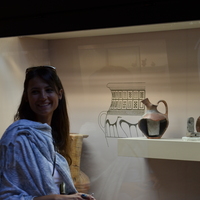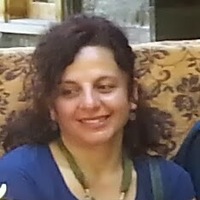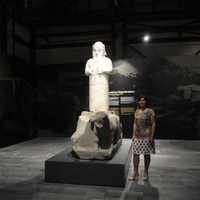
Sevgül Çilingir
Julius-Maximilians - Universität Würzburg, Lehrstuhl für Altorientalistik, Senior Fellow at "KFG 42 MagEIA: Magic between Entanglement, Interaction, and Analogy"
Assoc. Prof. at Ege University
MA at Ege University Ancient History Department: "The Sacred Cities of the Hittites". Supervisor-Prof. Dr. Süleyman Özkan (2009-2011)
PhD at Dokuz Eylül University Ancient History Department: "The Magical Rituals of Hittites and Their Segment Categories (CTH 390-470)". Supervisor-Prof. Dr. Recai Tekoglu (2012-2017)
Areas of interest: Hittite Religion, Magical Rituals, Hittite Myths, Religious Practices of the Hittites
DAAD Intensive Language Course Grant Scholar, Freiburg Goethe Institute, 2014 Summer.
Member of IAA (The International Association for Assyriology) since February, 2016.
TÜBİTAK 2219/A International Post-Doctoral Research Fellowship Program, (Julius-Maximilians University, Würzburg, Altorientalistik, May-December 2018-5 Months-Supervisor Prof. Dr. Daniel Schwemer)
Erasmus+ Teaching Mobility Program, Seminar series on "Hittite Ritual Tradition in a Comparative Perspective" with the collaboration of Dr. Michele Cammarosano. 15-18.11.2022
Current Project: The Sea in Hittite Culture. In collaboration with Dr. Michele Cammarosano. Supported by AKMED. 2020-2022.
Supervisors: Prof. Dr. Recai Tekoğlu
Phone: cilingirsevgul@gmail.com
Address: Ege University
MA at Ege University Ancient History Department: "The Sacred Cities of the Hittites". Supervisor-Prof. Dr. Süleyman Özkan (2009-2011)
PhD at Dokuz Eylül University Ancient History Department: "The Magical Rituals of Hittites and Their Segment Categories (CTH 390-470)". Supervisor-Prof. Dr. Recai Tekoglu (2012-2017)
Areas of interest: Hittite Religion, Magical Rituals, Hittite Myths, Religious Practices of the Hittites
DAAD Intensive Language Course Grant Scholar, Freiburg Goethe Institute, 2014 Summer.
Member of IAA (The International Association for Assyriology) since February, 2016.
TÜBİTAK 2219/A International Post-Doctoral Research Fellowship Program, (Julius-Maximilians University, Würzburg, Altorientalistik, May-December 2018-5 Months-Supervisor Prof. Dr. Daniel Schwemer)
Erasmus+ Teaching Mobility Program, Seminar series on "Hittite Ritual Tradition in a Comparative Perspective" with the collaboration of Dr. Michele Cammarosano. 15-18.11.2022
Current Project: The Sea in Hittite Culture. In collaboration with Dr. Michele Cammarosano. Supported by AKMED. 2020-2022.
Supervisors: Prof. Dr. Recai Tekoğlu
Phone: cilingirsevgul@gmail.com
Address: Ege University
less
Related Authors
Kurtuluş Kıymet
Kocaeli University
tevhide özeser
Kocaeli University
Esma Reyhan
Ankara Hacı Bayram Veli University
Rukiye Akdoğan
Cukurova University
hasan tuncer
Ankara University
InterestsView All (38)








Uploads
Papers by Sevgül Çilingir
This article aims to examine four unpublished tablet fragments with inventory numbers Bo 9301, Bo 9317, Bo 9343, and Bo 6806 that were returned from Berlin to Anatolian Civilizations Museum in 1987. The study provides the edition of the fragments including their transliterations, translations, philological comments, photographs and copies. All the fragments in question consist of religious
content and belong to the ritual texts.
Animals use a nonverbal communication, and they are assigned many various features in the semantic world of humans. Hittite texts often mention animals as well as their characteristics and use various expressions or similes that allow them to convey the emotions or describe particular situations. For the Hittites, husbandry was not just an economic activity. The meanings ascribed to both domesticated and wild animals have also been effective in shaping their culture. Animals were not only a source of food but also many gods were conceived in form of specific animals. Therefore, it is possible to single out some inferences about the Hittite culture by examining the texts in terms of animal symbolism. This study aims to investigate the symbolic and non-symbolic expressions of the wolf (UR.BAR.RA) in the texts and the place of the Wolf-men (LÚ.MEŠUR.BAR.RA) in Hittite cult.
Time is a phenomenon that is constantly in motion and which humankind can neither control nor free themselves from. For the Hittites, whose life and economy was mostly agrarian, time was the key element of life and stood at its center. Hittite texts include several terms defining seasons, different divisions of a day, and expressions that describe more limited seasonal or diurnal time segments. In this regard, time in the Hittite society is a multi-faceted research topic, which may be studied from various perspectives. This article focuses on the term “meḫur”, which, in Hittite texts, refers to a general concept of time. By discussing the meanings attributed to this concept in the first place, it is revealed that time as a phenomenon had more than one definition for the Hittites. Subsequently, phrases that contain meḫur and express a more limited time period are examined, and several points concerning the perception of time in Hittite literature are presented in conclusion.
Anadolu topraklarında din ile iç içe bir yaşam sürdüren Hitit insanı için ritüel, yeryüzünde ve yeraltında yaşayan tanrılarla iletişime geçmede başvurulan dini uygulamalardandır. Günümüze kadar çeşitli kazılarda ele geçirilen çok sayıda tablet parçasının büyük kısmını Hitit dini metinlerinin oluşturduğu görülür. Bu metinlerde, bayramlardan sonra en fazla bahsedilen konular ise ritüel uygulamalarıdır. Hitit insanı dünyevi yaşamda karşılaştığı hastalık, felaket, kara büyü, ölüm, salgın ve verimsizlik gibi olumsuz durumların üstesinden gelmenin ritüelle mümkün olduğuna inanıyordu. Büyü uygulamalarıyla harmanlanan ve kutsalla ilişki kurmanın yolunu açan ritüeller, Hitit toplumunun yaşadığı dünyayı algılama biçimi hakkında bilgi sağlarlar. Bu makale, arşivlerden ele geçirilen ritüel tabletlerinden yola çıkarak Hitit büyü ritüellerinin genel özelliklerine odaklanmakta ve böylece Hitit toplumunda, ritüellerin yaşamla ne kadar iç içe olduğunu ortaya koymayı amaçlamaktadır.
Abstract
Ritual is one of the most significant religious practices for Hittites to get into contact with deities living on earth and netherworld. It is also a well-known fact that a large number of cuneiform tablets mostly mention about religious activities and the descriptions of magical rituals alonside festivals are one of the main topics in written sources. For Hittites, one could deal with the problems such as illness, black magic, death, plague and infertility etc. by means of rituals. As blended with magical practices and give the chance of getting into cantact with their deities, ritual practices of Hittites inform us about how they tried to explain the mortal world they live in. This article mainly focuses on the general features of the magical rituals of Hittites by taking the cuneiform texts into consideration and aims at indicating to what extent these religious practices affected the daily life of Hittites.
Thesis by Sevgül Çilingir
Web by Sevgül Çilingir
What species of reed do I need to make a Babylonian stylus? How to cut it? How to hold it? --- A short guide for all interested people, based on first-hand research. English & Turkish versions available; Arabic & Italian forthcoming. Enjoy!
https://cuneiform.neocities.org/CWT/howtowritecuneiform.html
Books by Sevgül Çilingir
Talks by Sevgül Çilingir
MÖ 17. yüzyılda Anadolu'nun merkezi denebilecek bir noktada kurulan Hitit Devleti, izlediği yayılmacı politika ile etki alanını batıda Ege Denizi'nden doğuda İran'a kuzeyde Karadeniz'den güneyde Akdeniz ve Mezopotamya'nın içlerine kadar genişletmiştir. Üç tarafı denizle çevrili Anadolu yarımadasında yaklaşık 450 yıl boyunca merkezi bir güç olarak varlığını sürdüren Hitit Devleti için deniz, ticari ve politik açıdan önemli bir coğrafi unsur olmasının yanında kültürel anlamda da oldukça etkilidir. Bu nedenle özellikle mitoslar, ritüeller ve bayramlar gibi pek çok dini belgede deniz olgusuna yer verildiği görülür. Genellikle A.AB.BA Sümerogramı ve ona karşılık geldiği düşünülen Hititçe aruna- kelimesiyle ifade edilen denizin kimi metinlerde tanrılaştırıldığı da dikkati çeker. Hitit metinlerinde deniz için uygulanan en az iki ritüel ve kutlanan bir bayramın olması ya da Kumarbi Döngüsü başta olmak üzere çeşitli anlatılarda Deniz Tanrısının geçmesi, onun din içindeki önemli rolüne işaret eder. Koç Üniversitesi Suna&İnan Kıraç Akdeniz Medeniyetleri Araştırma Merkezi (AKMED) tarafından desteklenen "Hitit Kültüründe Deniz" başlıklı projenin ilk sonuçlarına yer veren bu çalışma, dini metinlerden yola çıkarak Hitit kültüründe deniz olgusunun sosyokültürel rolünü ve önemini incelemeyi amaçlamaktadır.
This article aims to examine four unpublished tablet fragments with inventory numbers Bo 9301, Bo 9317, Bo 9343, and Bo 6806 that were returned from Berlin to Anatolian Civilizations Museum in 1987. The study provides the edition of the fragments including their transliterations, translations, philological comments, photographs and copies. All the fragments in question consist of religious
content and belong to the ritual texts.
Animals use a nonverbal communication, and they are assigned many various features in the semantic world of humans. Hittite texts often mention animals as well as their characteristics and use various expressions or similes that allow them to convey the emotions or describe particular situations. For the Hittites, husbandry was not just an economic activity. The meanings ascribed to both domesticated and wild animals have also been effective in shaping their culture. Animals were not only a source of food but also many gods were conceived in form of specific animals. Therefore, it is possible to single out some inferences about the Hittite culture by examining the texts in terms of animal symbolism. This study aims to investigate the symbolic and non-symbolic expressions of the wolf (UR.BAR.RA) in the texts and the place of the Wolf-men (LÚ.MEŠUR.BAR.RA) in Hittite cult.
Time is a phenomenon that is constantly in motion and which humankind can neither control nor free themselves from. For the Hittites, whose life and economy was mostly agrarian, time was the key element of life and stood at its center. Hittite texts include several terms defining seasons, different divisions of a day, and expressions that describe more limited seasonal or diurnal time segments. In this regard, time in the Hittite society is a multi-faceted research topic, which may be studied from various perspectives. This article focuses on the term “meḫur”, which, in Hittite texts, refers to a general concept of time. By discussing the meanings attributed to this concept in the first place, it is revealed that time as a phenomenon had more than one definition for the Hittites. Subsequently, phrases that contain meḫur and express a more limited time period are examined, and several points concerning the perception of time in Hittite literature are presented in conclusion.
Anadolu topraklarında din ile iç içe bir yaşam sürdüren Hitit insanı için ritüel, yeryüzünde ve yeraltında yaşayan tanrılarla iletişime geçmede başvurulan dini uygulamalardandır. Günümüze kadar çeşitli kazılarda ele geçirilen çok sayıda tablet parçasının büyük kısmını Hitit dini metinlerinin oluşturduğu görülür. Bu metinlerde, bayramlardan sonra en fazla bahsedilen konular ise ritüel uygulamalarıdır. Hitit insanı dünyevi yaşamda karşılaştığı hastalık, felaket, kara büyü, ölüm, salgın ve verimsizlik gibi olumsuz durumların üstesinden gelmenin ritüelle mümkün olduğuna inanıyordu. Büyü uygulamalarıyla harmanlanan ve kutsalla ilişki kurmanın yolunu açan ritüeller, Hitit toplumunun yaşadığı dünyayı algılama biçimi hakkında bilgi sağlarlar. Bu makale, arşivlerden ele geçirilen ritüel tabletlerinden yola çıkarak Hitit büyü ritüellerinin genel özelliklerine odaklanmakta ve böylece Hitit toplumunda, ritüellerin yaşamla ne kadar iç içe olduğunu ortaya koymayı amaçlamaktadır.
Abstract
Ritual is one of the most significant religious practices for Hittites to get into contact with deities living on earth and netherworld. It is also a well-known fact that a large number of cuneiform tablets mostly mention about religious activities and the descriptions of magical rituals alonside festivals are one of the main topics in written sources. For Hittites, one could deal with the problems such as illness, black magic, death, plague and infertility etc. by means of rituals. As blended with magical practices and give the chance of getting into cantact with their deities, ritual practices of Hittites inform us about how they tried to explain the mortal world they live in. This article mainly focuses on the general features of the magical rituals of Hittites by taking the cuneiform texts into consideration and aims at indicating to what extent these religious practices affected the daily life of Hittites.
What species of reed do I need to make a Babylonian stylus? How to cut it? How to hold it? --- A short guide for all interested people, based on first-hand research. English & Turkish versions available; Arabic & Italian forthcoming. Enjoy!
https://cuneiform.neocities.org/CWT/howtowritecuneiform.html
MÖ 17. yüzyılda Anadolu'nun merkezi denebilecek bir noktada kurulan Hitit Devleti, izlediği yayılmacı politika ile etki alanını batıda Ege Denizi'nden doğuda İran'a kuzeyde Karadeniz'den güneyde Akdeniz ve Mezopotamya'nın içlerine kadar genişletmiştir. Üç tarafı denizle çevrili Anadolu yarımadasında yaklaşık 450 yıl boyunca merkezi bir güç olarak varlığını sürdüren Hitit Devleti için deniz, ticari ve politik açıdan önemli bir coğrafi unsur olmasının yanında kültürel anlamda da oldukça etkilidir. Bu nedenle özellikle mitoslar, ritüeller ve bayramlar gibi pek çok dini belgede deniz olgusuna yer verildiği görülür. Genellikle A.AB.BA Sümerogramı ve ona karşılık geldiği düşünülen Hititçe aruna- kelimesiyle ifade edilen denizin kimi metinlerde tanrılaştırıldığı da dikkati çeker. Hitit metinlerinde deniz için uygulanan en az iki ritüel ve kutlanan bir bayramın olması ya da Kumarbi Döngüsü başta olmak üzere çeşitli anlatılarda Deniz Tanrısının geçmesi, onun din içindeki önemli rolüne işaret eder. Koç Üniversitesi Suna&İnan Kıraç Akdeniz Medeniyetleri Araştırma Merkezi (AKMED) tarafından desteklenen "Hitit Kültüründe Deniz" başlıklı projenin ilk sonuçlarına yer veren bu çalışma, dini metinlerden yola çıkarak Hitit kültüründe deniz olgusunun sosyokültürel rolünü ve önemini incelemeyi amaçlamaktadır.